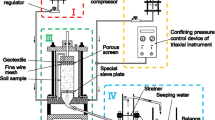Abstract
Piping is a complicated natural phenomenon of internal erosion, which threatens the safety of hydraulic earth structures. Despite of the comprehensive research aiming to figure out the onset condition and development of piping, there is little element experiment in laboratory regarding the mechanical properties of disturbed soil. In this paper, as an attempt to create piping erosion under controlled conditions, glucose with certain shape and volume was placed in sand samples. With the dissolution of glucose pipes, artificial piping erosion was reproduced. Based on this approach, a series of experiments were performed in a hollow cylindrical torsional shear apparatus under different confining pressures for both intact specimens and eroded ones. Strains during piping propagation were measured by local sensors. Shear modulus was obtained by conducting torsional cyclic loadings with peak to peak stress magnitude of 4 kPa under various directions of principal stress axes. Furthermore, shear strength and the development of shear band were studied. The results clearly indicate the weakened mechanical behavior of sand subjected to piping erosion. Influence of piping-induced anisotropic fabric on shear strength and shear band was also confirmed.
Similar content being viewed by others
References
Arthur, J. R. F. and Menzied, B. K. (1972). “Inherent anisotropy in a sand.” Geotechnique, Vol. 22, Issue 1, pp. 115–128, DOI: 10.1680/geot.1972.22.1.115.
Benahmed, N. and Bonelli, S. (2012). “Investigating concentrated leak erosion behaviour of cohesive soils by performing hole erosion tests.” European Journal of Environmental and Civil Engineering, Vol. 16, No. 1, pp. 43–58, DOI: 10.1080/19648189.2012.667667.
Bonelli, S., Brivois, O., Borghi, R., and Benahmed, N. (2006). “On the modeling of piping erosion.” Comptes Rendus Mecanique, Vol. 334, No. 8, pp. 555–559, DOI: 10.1016/j.crme.2006.07.003.
Goto, S., Tatsuoka, F., Shibuya, S., Kim, Y. S., and Sato, T. (1991). “A simple gauge for local small strain measurements in the laboratory.” Soils and Foundations, Vol. 31, No. 1, pp. 169–180, DOI: 10.3208/sandf1972.31.169.
Hanson, G. J. and Cook, K. R. (2004). “Apparatus, test procedures, and analytical methods to measure soil erodibility in situ.” Applied Engineering in Agriculture, Vol. 20, No. 4, pp. 455–462, DOI: 10.13031/2013.16492.
Han, C. and Drescher, A. (1993). “Shear bands in biaxial tests on dry coarse sand.” Soils and Foundations, Vol. 33, No. 1, pp. 118–132, DOI: 10.3208/sandf1972.33.118.
Hardin, B. O. and Drnevich, V. P. (1972). “Shear modulus and damping in soils: Design equations and curves.” Soil Mechanics and Foundations Div. ASCE, Vol. 98, Issue 6, pp. 603–624, DOI: 10.1016/0022-4898(73)90212-7.
Hardin, B. O. and Richart, F. E. (1963). “Elastic wave velocities in granular soils.” Soil Mechanics and Foundations Div. ASCE, Vol. 89, Issue 1, pp. 33–65.
Hight, D. W., Gens, A., and Symes, M. J. (1983). “The development of a new hollow cylinder apparatus for investigating the effects of principal stress rotation in soils.” Geotechnique, Vol. 33, No. 4, pp. 355–383, DOI: 10.1680/geot.1983.33.4.355.
Ishibashi, I. and Zhang X. (1993). “Unified dynamic shear moduli and damping ratios of sand and clay.” Soils and Foundations, Vol. 33, No. 1, pp. 182–191, DOI: 10.3208/sandf1972.33.182.
Fry, J. J. (2016). “Lessons on internal erosion in embankment dams from failures and physical models.” Proceedings of the 8th International Conference on Scour and Erosion, pp. 39–56.
Luo, Y. L., Qiao, L., Liu, X. X., Zhan, M. L., and Sheng, J. C. (2013). “Hydro-mechanical experiments on suffusion under long-term large hydraulic heads.” Natural Hazards, Vol. 65, No. 3, pp. 1361–1377, DOI: 10.1007/s11069-012-0415-y.
Nguyen, H. and Koseki, J. (2005). “Quasi-elastic deformation properties of Toyoura sand in cyclic triaxial and torsional loadings.” Soils and Foundations, Vol. 45, No. 5, pp. 19–38.
Renuka, I. H. S. and Kuwano, R. (2011). “Formation and evaluation of loosened ground above a cavity by laboratory model tests with uniform sand.” Proc. of 13th International Summer Symposium, Uji, Japan, pp. 211–214.
Renuka, I. H. S. (2012). “Evaluation of ground loosening behavior and mechanical properties of loosened sand associated with underground cavities.” Master Dissertation, Department of Civil Engineering, University of Tokyo.
Sakurai, M. (2014). “Landslide disaster of Izu-Oshima Island by Typhoon No. 26 in 2013.” Journal of the Japan Landslide Society, Vol. 51, No. 1, pp. 25–28, DOI: 10.3313/jls.51.25.
Stokoe, K. H., Lee, S. H. H., and Knox, D. P. (1985). “Shear moduli measurements under true triaxial stresses.” Advances in the Art of Testing Soils Under Cyclic Conditions, ASCE, pp. 166–185.
Tatsuoka, F., Nakamura, S., Huang, C. C., and Tani, K. (1990). “Strength anisotropy and shear band direction in plane strain tests of sand.” Soils and foundations, Vol. 30, No. 1, pp. 35–54, DOI: 10.3208/sandf1972.30.35.
Tatsuoka, F. and Shibuya, S. (1992). “Deformation characteristics of soils and rocks from field and laboratory tests.” Proc. 9th Asian Regional Conference on SMFE, 2, pp. 101–170.
Wan, C. F. and Fell, R. (2004). “Investigation of rate of erosion of soils in embankment dams.” Journal of Geotechnical and Geoenvironmental Engineering, Vol. 130, No. 4, pp. 373–380, DOI: 10.1061/(ASCE)1090-0241(2004)130:4(373).
Wong, R. K. S. and Arthur, J. R. F. (1985). “Induced and inherent anisotropy in sand.” Geotechnique, Vol. 35, No. 4, pp. 471–481, DOI: 10.1680/geot.1985.35.4.471.
Yoshida, T., Tatsuoka, F., Kamegai, Y., Siddiquee, M. S. A., and Park, C. S. (1994). “Shear banding in sands observed in plane strain compression.” Proc. 3rd Int. Workshop on Localization and Bifurcation Theory for Soils and Rocks, Balkema, Rotterdam, The Netherlands, pp. 165–179.
Yu, P. and Richart, F. E. (1984). “Stress ratio effects on shear modulus of dry sands.” Journal of Geotechnical Engineering, Vol. 110, Issue 3, pp. 331–345, DOI: 10.1061/(ASCE)0733-9410(1984)110:3(331).
Author information
Authors and Affiliations
Corresponding author
Rights and permissions
About this article
Cite this article
Yang, Y., Kuwano, R. An Experimental Investigation of Piping Effects on the Mechanical Properties of Toyoura Sand. KSCE J Civ Eng 22, 2810–2819 (2018). https://doi.org/10.1007/s12205-017-0314-6
Received:
Revised:
Accepted:
Published:
Issue Date:
DOI: https://doi.org/10.1007/s12205-017-0314-6




